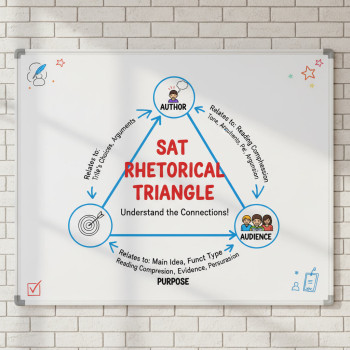Why test fatigue matters more than you think
Picture this: you’re 90 minutes into a full-length SAT. You’ve powered through reading passages and math problems, and then you hit a sentence completion that looks easy — but suddenly your mind blanks. You re-read it three times, second-guess every choice, and watch the minutes tick away. That tiny wobble isn’t just nerves; it’s test fatigue at work.
Test fatigue is a real, measurable decline in cognitive performance that builds as you work on demanding tasks. For students taking the SAT — a multi-section, high-stakes exam that tests reasoning, memory, attention, and problem solving over roughly three hours — fatigue is an important factor. It can nudge a B into a C, slow your reading speed, fuzzy your math computations, and make the difference between an answer you know and one you rush through incorrectly.
What test fatigue looks like on the SAT
- Slower reading and scanning of passages;
- Reduced accuracy on multi-step math problems;
- More careless errors (wrong bubble, misread question, skipped steps);
- Decision fatigue during multiple-choice sections — selecting the first seemingly reasonable answer instead of the best one;
- Sudden difficulty concentrating on questions you handled easily in practice.
The science behind the slowdown
Understanding why fatigue happens helps you fight it. When you focus intensely for long periods you use up neural resources tied to attention and working memory. The prefrontal cortex, which handles planning and reasoning, is particularly sensitive to prolonged demand. Over time, it gets less efficient: reaction times increase, your ability to resist distraction drops, and complex problem solving feels heavier.
Biological factors play a role, too. Glucose is the brain’s primary fuel, and mental effort consumes it locally; a long session can cause subtle dips in the energy available for demanding cognitive tasks. Hormones like cortisol respond to stress, and if anxiety spikes, it can accelerate mental exhaustion. Circadian rhythms matter — a night owl who tests early in the morning may hit a performance valley simply because their internal clock isn’t aligned.
Evidence in simple terms
Researchers call the decline in sustained attention the “vigilance decrement.” In plain English: over a long period, your ability to notice and respond correctly to important details decreases. That’s why the same student scores consistently on practice sections taken in short bursts but makes more mistakes on full-length practice tests. Fatigue doesn’t look dramatic; it’s the creeping small errors that add up.
How test fatigue specifically affects each SAT section
Different SAT sections tax the brain in different ways. Recognizing those differences helps you tailor strategies.
Reading
Reading-heavy sections demand sustained attention, inference-making, and memory for passage structure. As fatigue grows, students often skim more, lose track of the author’s main point, and misinterpret tone or purpose. Time pressure amplifies the problem — rushed skimming is where careless mistakes thrive.
Writing and Language
These questions require close grammatical analysis and spotting concise phrasing. Fatigue makes you accept the first answer that looks “good enough” rather than the most precise option. When your brain is tired, the subtle differences between choices blur.
Math
Math on the SAT ranges from quick arithmetic to multi-step algebra and problem solving. Fatigue affects working memory and error-checking, so multi-step problems are especially vulnerable. A minor arithmetic slip or a skipped negative sign is more likely late in the test.
Real students, real patterns
Consider Maya, a junior who consistently scored well on 20–30 minute practice sections but saw her full-length practice score drop 60 points. After keeping a study log, she noticed the last 30 minutes of each practice test were full of silly mistakes. By shifting to spaced practice, adding short movement breaks, and eating a balanced pre-test breakfast, she recovered those points. A few tweaks — like timed mini-sprints and post-section checklists — turned fatigue into manageable friction instead of a score killer.
Or think about David, who relied on quick energy drinks right before the exam. They gave him a jittery energy spike but then a crash mid-test. Changing to a protein-rich breakfast and a small, slow-digesting snack during the break stabilized his performance.
Strategies to prevent and manage test fatigue
There are three times to act: before the test (build stamina), during the test (manage energy), and while studying (train for fatigue). Each requires different tactics.
Before test day — build your cognitive endurance
- Sleep: Prioritize consistent sleep schedules. Your brain consolidates learning during deep sleep and restores attentional resources. Aim for 7–9 hours most nights for weeks leading up to the test, not just the night before.
- Nutrition: A breakfast with protein, complex carbs, and healthy fats sustains attention. Think eggs, whole-grain toast, and fruit rather than a sugar-heavy pastry.
- Practice with full-length tests: Simulate the real SAT at least a few times under timed, uninterrupted conditions. Build up from shorter sessions so your brain adapts to the stamina needed.
- Progressive overload: Gradually increase the length and difficulty of practice sessions. Just as athletes build endurance, students can increase cognitive stamina by slowly extending focus periods.
- Mindfulness and stress reduction: Short breathing or grounding exercises reduce cortisol spikes and help preserve cognitive control under pressure.
During the test — small moves that save points
- Pacing strategy: Break the test into chunks. Aim for steady progress rather than sprinting through early sections and running out of steam.
- Smart checking: For multi-step math problems, mark the line where you’ll re-check your work if time allows. For reading, jot a tiny keyword note to reset when you return to the question.
- Micro-breaks: Use permitted pauses to close your eyes for 10–15 seconds, take several deep breaths, stretch neck and shoulders, and reset focus.
- Snack timing: If you’re allowed a small snack during the scheduled break, choose protein or mixed carbs (nuts, yogurt, whole-grain crackers) to avoid sugar crashes. Hydration matters — sip water, but don’t overdo it.
- Decision hygiene: When you feel overwhelmed, apply a simple rule: if you can eliminate two wrong answers, pick the best of the rest and move on. Prolonged second-guessing is a fatigue trap.
While studying — train in a way that reduces fatigue on test day
- Distributed practice: Spread learning across weeks. Spacing strengthens memory and reduces the intensity of any single session.
- Interleaving: Mix different topics and question types within study sessions to increase adaptability and reduce monotony.
- Simulated fatigue sessions: Practice tests should mimic test-day conditions; include the same timing, breaks, and materials to teach your brain how to perform under weariness.
- Active recovery: Use light exercise, walks, or short naps after intense study to consolidate gains and avoid burnout.
Quick, actionable checklist for the week before the SAT
One week is short, but strategic choices can make a measurable difference.
- Reduce heavy new learning; focus on review and problem types that commonly cause errors.
- Keep sleep consistent — no late-night cramming binges.
- Run one full-length practice test mid-week under real conditions, then use the remainder of the week for light, confidence-building review.
- Plan your test-day meal and pack approved snacks and water.
- Prepare a calming pre-test routine: a 5–10 minute breathing sequence, a positive affirmation, or a short walk to reduce jitters.
Practical examples: that small change that makes a big difference
Small shifts often beat big promises. Here are three concrete experiments you can try and measure.
- Timing your practice: Replace your last 30 minutes of a practice session with 30 minutes of low-intensity review (flashcards, quick grammar drills). See if your error rate in the final section falls on subsequent full tests.
- Snack trial: Try three different test-break snacks across practice tests (banana and almond butter, yogurt and berries, small granola bar) and monitor which keeps your focus best without a post-snack dip.
- Micro-break routine: Practice closing your eyes and breathing for 15 seconds between sections. Track whether mental clarity after breaks improves and how quickly you regain focus.
Tools and supports that help — and when to use them
Structured help makes fatigue easier to manage. A tailored study plan that accounts for personal energy patterns shortens the learning curve. For many students, working with an experienced guide reduces trial-and-error and personalizes strategies.
Sparkl’s personalized tutoring offers a blend of 1-on-1 guidance, tailored study plans, expert tutors, and AI-driven insights that can pinpoint when fatigue tends to strike and adjust schedules accordingly. Tutors can design practice sessions that build stamina gradually, suggest the best nutrition and pacing tweaks for your body clock, and reinforce test-day routines until they feel natural. If you find you repeatedly lose points late in the test, personalized coaching helps translate data from practice tests into small, targeted changes.
A practical table: strategies, benefits, and how long until you see improvement
| Strategy | Primary benefit | Time to implement | When you’ll likely see improvement |
|---|---|---|---|
| Consistent sleep schedule | Improves attention, memory consolidation | Start 2–3 weeks before the test | 1–2 weeks |
| Full-length practice tests | Builds stamina, reveals late-test weaknesses | Begin 4–6 weeks out, once per week | After 2–3 full tests |
| Distributed and interleaved practice | Better retention and adaptability | Start immediately | 2–4 weeks |
| Smart nutrition & hydration | Reduces energy crashes | Test week | Immediate on test day |
| Micro-break breathing routine | Reduces anxiety, resets focus | Practice during study sessions | 1–2 practice sessions |
Common myths about fatigue (and the truth)
- Myth: “Cramming the night before will make up for lack of stamina.” Truth: Cramming can impair sleep and increase fatigue; distributed practice is far more effective.
- Myth: “Energy drinks are a reliable shortcut.” Truth: They can cause jitteriness followed by a crash — not a dependable long-game strategy.
- Myth: “If you’re calm, you won’t get fatigued.” Truth: Calm helps, but even calm, focused work consumes cognitive resources; you still need strategies to manage endurance.
Putting it all together: a sample 6-week plan
This is a scaffolded approach that balances skill-building with stamina training:
- Weeks 1–2: Establish consistent sleep, begin distributed study sessions (45–60 minutes), and introduce interleaving. Start a weekly timed section to benchmark pacing.
- Weeks 3–4: Add one full-length practice test per week under exam conditions. Practice micro-breaks and test-break nutrition. Adjust pacing strategies based on error patterns.
- Weeks 5–6: Maintain sleep and nutrition, shift to lighter review after the final full-length practice test, and reinforce test-day routines. Use focused practice on weak question types and rehearse micro-breaks.
Throughout, track errors by section and by time of test to spot fatigue-driven patterns. If certain question types consistently drop late in the test, increase targeted practice in those areas while maintaining stamina work.
Final thoughts: stamina is a skill, not a fixed trait
Test fatigue feels inevitable, but it’s not destiny. With consistent habits, practice that simulates the testing environment, and small test-day strategies, you can preserve mental clarity across the long haul of the SAT. Like training for a long run, you don’t suddenly become fit the night before — you build endurance with intentional, incremental work.
If you’re unsure where to start, a personalized approach helps. Sparkl’s tutors can design study plans that match your energy rhythms, identify when you’re most vulnerable to fatigue, and create targeted work that boosts both skill and stamina. The right combination of sleep, nutrition, pacing, and practice will leave you confident and sharper on test day — and that’s where better scores begin.


Quick recap: what to do this week
- Schedule one simulated full-length practice under test conditions.
- Lock in a consistent sleep schedule and plan a balanced test-day breakfast.
- Practice quick micro-breaks and a simple checking routine for math problems.
- If you need a tailored plan, consider 1-on-1 guidance to translate practice-test data into a fatigue-proof strategy.
Test fatigue is solvable. With the right preparation, you’ll arrive on SAT day not just smarter, but steadier — ready to turn endurance into an advantage.
















No Comments
Leave a comment Cancel